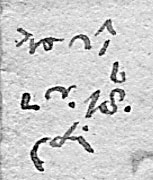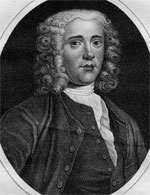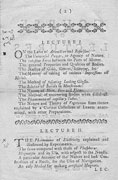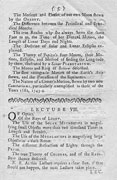Benjamin Martin: London lectures and the 1756 syllabus
This note discusses an undated single-sheet syllabus for 14 lectures on natural philosophy by Benjamin Martin, a scientific lecturer and instrument maker who settled in London in the mid-1750s. The syllabus was donated to the Museum of the History of Science, Oxford by John R. Millburn in 2004.

The sheet has two small groups of (probably related) marginalia. One group is in ink, the other in pencil. The ink annotations consist of what appears to be shorthand against the heading of lecture I, as well as small crosses against lectures I–III. (I’ve tentatively suggested one explanation for the crosses towards the end of the article.) Pencil is used for a series of numbers against lectures II–VIII, including a more extended annotation at lecture VI, which appears to be a combination of shorthand and a number.
There is not really sufficient material here to decide whether these are two different hands at work, or the same person on different occasions with a different writing implement. However, there are two points which might suggest that the marginalia are all by the same person: shorthand seems to be used in both ink and pencil; and there appears to be a single numerical sequence from the ink of lecture I through the pencil annotations on lectures II–VIII.
John Millburn accompanied his generous donation with a paper analysing the syllabus in order to establish its date. He plumped for c. 1758, while acknowledging that it might have come from a couple of years earlier, just after Martin settled in London. When writing my initial account, I inferred from the number sequence that the marginal annotations were dates from mid-February to early March in a leap year. The combination of internal evidence and the fact that this leap year’s February contains five Sundays suggested that the year was 1756.
This suggestion can now be confirmed. Through his extensive study of newspaper advertisements, John Millburn again pointed the way. His detailed Martin Bibliography (1998) lists all the adverts by Martin that he had seen. With typical candour he records that he had not examined London’s Public Advertiser for the period January–July 1756.
If the marginal numbers really were dates then the lecture course began on 18 February 1756. A lecture announcement matching both this date and the content of the syllabus would be a conclusive demonstration, for the 1756 dates do not match those of any later courses documented by Millburn.
Precise prediction is usually imagined to be more the province of the sciences than history. So I wound the Early English Newspapers microfilm towards Wednesday 18 February 1756 with an unfamiliar mixture of expectation and dread. But there, as I had hoped, was an advert in The Public Advertiser beginning “MR BENJ. MARTIN this Evening will read the first Lecture of his Course”. There then follows a detailed synopsis of the opening lecture which matches (often verbatim) the listing of the syllabus, so there can be no doubt that the syllabus accompanied these 1756 lectures.
The advert immediately became the earliest evidence for the first steps in Martin’s successful London lecturing career. But it was more. It refers to his “Lecture Room two Doors below Crane-court, Fleet street”, providing the first evidence for his establishment at this fashionable address close to the Royal Society. Best of all, the advert closes with a human touch which made me laugh out loud: “The Gentleman who exchanged his Hat on Sunday Night last at Mr. Martin’s Lecture, is desired to leave it at his Shop, where he may have his own returned him.” But this is not just funny: it tells us that Martin’s lecture room was also a shop and that the course which began on that Wednesday was not his first foray into lecturing.
Taking the hint, a trawl through earlier numbers of The Public Advertiser reveals that Martin gave at least one earlier course at his Fleet Street address, beginning in January 1756. The details will follow here shortly [that's not true - it looks like I posted this in September 2005 and I haven't done it by February 2008], but even a cursory examination indicates that the same syllabus would have served for that series too.
The newspaper evidence puts the dating of the syllabus beyond reasonable doubt. But the syllabus has further information to reveal. When writing my original article I was working from a partial scan rather than the original document. (I was actually on holiday....) Before considering how to tackle 18th-century newspapers (which I had never worked with before), a question about the shorthand prompted me to return to the original document. I immediately realised that I had blundered: I had recorded annotations against only the first seven lectures. Somehow I had overlooked an annotation against lecture VIII: a 3 surmounted by a superscript d. And not only that, but I now noticed that the 3 against lecture VII had been scored through.
I had interpreted the 3 against lecture VII as representing the 3rd of March 1756. So my first reaction on seeing that this had been deleted and the 3 set against the next lecture was one of alarm: was my calendrical interpretation (at that stage not even in print yet) embarrassingly wrong? Fortunately the syllabus itself suggested a reading which was not only face-saving but offers fresh illumination on Benjamin Martin’s lecturing practice. Moreover, the newspapers from February 1756 provide further confirmation (details to be added here shortly [another fib, this hasn't happened yet either]).
Martin’s lecture VII was on optics and included demonstrations of a solar microscope, his ‘megalascope’ in a darkened room, and refraction through a prism. At the end of the lecture synopsis he adds “N.B. As this Lecture requires a clear Sun, if that should not happen, the next Lecture takes place.” The apparent change of date from lecture VII to VIII would therefore indicate that Wednesday 3 March 1756 was a cloudy day!
While this is meteorologically plausible, it does raise a further question. John Milburn notes in his analysis of the syllabus that, from 1756 onwards, Martin experimented with the starting times of his London lectures. His earliest documented lectures were at 6pm, but he changed to 6.30pm in January 1757 and then again to 7pm in January 1761 (Millburn 2004). Using a convenient tool such as Keith’s Java astrolabe it can quickly be shown that sunset in London on 3 March 1756 was at about 5.45pm. A lecture beginning at 6pm on this day could never have enjoyed “a clear Sun”.
John Millburn had already documented the solution to this apparent problem. In volume II of his Martin Bibliography (1998) he transcribed the advertisements which Martin placed for the optical demonstration session in his lecture series. While his lectures were generally evening events, for a year or two after his establishment in London, Martin staged this optical lecture at 11am, when the sun would hopefully be at its brightest. Thus he publicised his lecture on fluids in The Daily Advertiser on 28 January 1757 with the added note that on the first fine day he would demonstrate the solar microscope and other instruments at 11am. During another course towards the end of the same year he announced his lecture on light, colours, vision, etc and again added the comment that the solar microscope, camera obscura and others would be demonstrated at 11am, on the first day the Sun is likely to be clear for an hour (The Daily Advertiser, 18 November 1757). Three days later he announced that the solar microscope lecture would be at 11am if the Sun was clear; otherwise the lecture would be at 6.30pm on optical instruments.
The distinct evening session on optical instruments was evidently a more standard lecture which did not require direct sunlight. Martin’s advertisements exactly match the provisions of the syllabus which allow the demonstrations of lecture VII on optics to be replaced by lecture VIII on optical instruments and vision. In later years the weather-dependent morning demonstration seems to have been dropped, with only the regular (lecture VIII) evening session remaining. However, when a fresh marketing opportunity arose, Martin was willing to try a similar arrangement again: in 1772 he had a “new-invented opake solar microscope” which was the centre piece of a ‘Philosophical Exhibition’ from May to June. The Daily Advertiser entries record that, with an hour’s notice, he would conduct a daytime tour, but cautioned that ‘for this purpose a clear sun will be necessary, at least for the greatest part of two hours and a half’ (1 June).


